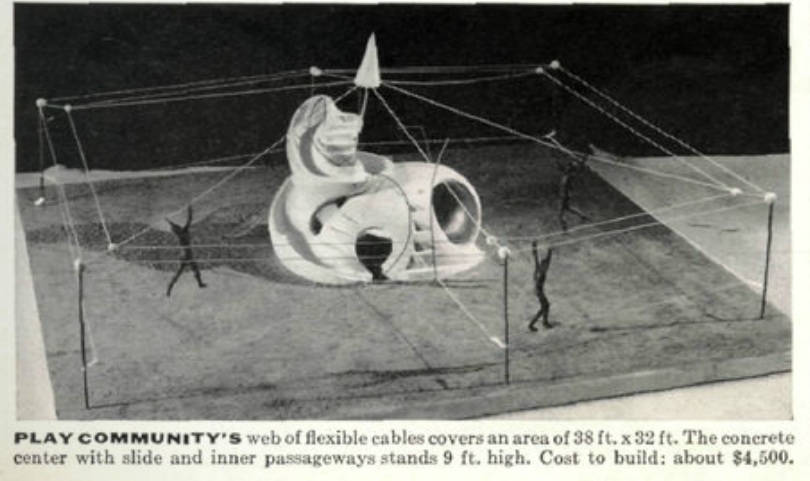
In preparing for our upcoming focus on risk here at Playscapes (in conversation with the great Tim Gill, over at RethinkingChildhood), I’ve been mulling over the question of whether we are as much ‘disappointment-averse’ as risk-averse; over worried about equivalency as much as safety on the playground.
And that makes me think of Joseph Brown, sometime boxer and sculptor, who saw his playground equipment as having the noblest of goals, and thought that frustration was not only good for a child, but could be fun. From Sports Illustrated, Nov 1, 1954:
To Princeton Professor Joseph Brown, play is “nature’s way of preparing a child for the struggles of maturity.” As such, he believes that play apparatus should be continuously challenging to the youngsters using it.
Despairing of the ordinary, rigid equipment, Joe Brown decided four years ago to fashion some of his own. At the National Recreation Association meeting in St. Louis, he unveiled his results: models pictured here which many of the recreation leaders hail as “the most revolutionary idea for play yards in the past 50 years.”
In designing this equipment, Brown explained, he took into account two facts of life: 1) an individual’s decisions must be partly conditioned by the actions of others. 2) Life is unpredictable.
WEB OF UNPREDICTABILITY
The Play Community shown below consists of two main elements. Its central part is concrete crisscrossed with a web of steel cables covered with nylon rope. The cables radiate from a ball and socket joint to flexible poles on the perimeter. When a child clambers along the cables his movement is transmitted to the rest of the strands and the entire network moves, complicating the lives of everyone concerned. Although the motion is not violent enough to fling a child off, it does draw him off balance unless he learns to give and take at the right moment.
The hollow concrete element, built so that children can play inside as well as outside, holds its share of unpredictability, too. To get to the top, for example, a child can take the curved step just so far, after which he must improvise a route to climb higher.
Once on top, he meets what Brown terms “a planned disappointment.” The spiral slide looks as if it circles to the ground. Half-way down, however, it levels off, and a youngster must make a decision and act on it. He can climb onto the curved ledge, or swing to the cables, or remain seated and push two or three times until he reaches a second slide going to the bottom.
The Whale Yard (left), a modification of the Play Community, enables youngsters of various ages to play together without getting in each other’s way. Toddlers can crawl inside while older children can use the ropes, climb on top or play on the slide in the whale’s tail.
The Spring-Tree (below) has a trunk of spring steel and branches of rope. The higher the youngsters scramble up the strands the more the entire tree will pitch and sway.
Last week, as construction of the first Spring-Tree and Whale Yard began for a Philadelphia city playground, designer Brown quipped: “This equipment may teach a child for the first time that there are trouble-makers in the world but that it’s hard to put your finger on the right one.”
The post Joseph Brown’s Frustrating Playgrounds, 1954 appeared first on Playscapes.